Today we are going to be discussing worm composting and vermiculture. Using worms to eat your waste organic matter from the kitchen can be a very convenient method of making black gold. Not only do these red wigglers produce a richer soil amendment than traditional compost (higher in nitrogen, phosphorous, and potash), they make it faster than their microbial compost pile counterparts. Worm composting has a number of additional advantages over traditional composting, some of which include:
- Can be done both indoors and outdoors (depending on temperatures)
- Takes a fraction of the space as traditional compost piles and is portable
- Easy to continue composting during the winter without braving the snow or rain
- Kid-friendly (my 4 year old daughter adds the daily scraps)
- The compost (worm castings) and compost tea is readily accessible
- Easy to expand capacity
- Can be shared with your community and friends
I will offer a brief overview of how to set up a worm composting system, and then describe my current strategy for increasing my own capacity for composting and supplying friends and family with their own systems.
What Do You Need To Get Started?
A Container
There are many types of containers that can be used for worm composting. They range from recycled materials (wooden boxes, coolers, plastic tubs) to complete systems that can be purchased at your local garden store or online. Your container should have adequate ventilation (worms need to have access to air) and drainage to maintain moisture levels (holes in the bottom of your container and a tray or second container on risers to sit your primary container on).

The size of the container should be big enough to support the amount of food scraps you produce on a daily basis. It is recommended that for every pound of food scraps, you have one square foot of surface area. The container should be at least 6 to 12 inches deep to allow for enough depth to cover your scraps when you feed your worms.
Your container should also have a cover to keep out light (worms don’t like the light) and help maintain moisture. Also, a secure lid can help keep pests and the family pet out of the container.
Bedding
When establishing a new composting system, you will need to create a bedding material for the worms to live in initially. Recommended materials include such things as moistened shredded newspapers or office paper, shredded cardboard, peat moss, coconut coir, or some soil or mostly finished compost. I have found that a moistened mixture of peat moss, dirt, and shredded leaves works well. The correct moisture level is like a wrung-out sponge.

Many materials will work, but the key things to keep in mind are that the bedding should be able to hold slight moisture, that it will allow for the worms to move through, and that there is enough bedding both for the worms to live in and to cover the first round of food being put into the bin.
What Kind of Worms?
There are two types of wigglers commonly used for composting systems. They are the redworms: Eisenia foetida (red wigglers, brandling, or manure worms) and Lumbricus rubellus.
Worms are usually purchased through an online specialty store or garden supply-store, but I highly recommend trying to get a container of worms from a friend or someone within your community. And if you are feeling really ambitious, you can harvest worms from mature manure and compost piles. You will need about 1000-2000 worms to start.
What to feed (or not feed) your worms?
You can feed your worms most fruit and vegetable scraps (avoid citrus), crushed egg shells, and coffee and tea grounds (including the filters but no staples).
Food items to avoid putting in your worm composter include meat scraps, oily foods, dairy items, and other items that would be indigestible to worms (plastic labels, foil, and twist ties -- no trash, please).
To prevent bug and odor problems, bury the food waste by pulling aside some of the bedding, dumping the waste, and then covering it up with the bedding you set aside. Rotate your feeding locations so as not to overload one particular spot. If mold begins to grow, this could be a sign that you are overfeeding the worms. In this case, cut back on their food and make sure to stir and cover food better with bedding going forward.
Where Should You Locate A Worm Bin?
As mentioned earlier, worms can be kept both indoors and outdoors, as long as they are kept within a temperature range of 45-80 degrees F, away from intense direct light, and out of heavy rains. I like to keep mine in the laundry room during the winter and on the shaded back porch during the summer months. If space is available, some people like to keep their worm composters under the kitchen sink or cabinet for direct access and feeding.
Maintaining the Worm Composter
Feed your worms and maintain good moisture (think "wrung-out sponge"), and your worms will eat their own weight in food every day and transform their starting bedding material into worm castings (a.k.a. black gold!) in 3-4 months.
Once you have established a good base of castings in your composter, you can begin harvesting. The simplest method is to add new bedding and food to one side of the composter, let the worms migrate to this new area, and harvest the castings from the opposite side.
Another method is to dump out the entire composter onto a plastic sheet, pick out the worms one at a time, and save them for your next composter setup with fresh bedding. Keep an eye out for baby worm cocoons (tiny lemon-shaped pods) to add with the sorted worms. This method is a bit more labor-intensive, but it can be a great family project that will help you maximize your casting harvest.
Now that you have good baseline knowledge about worm composting, I invite you to set up a worm composter. Worm castings are some of the best compost you will ever work with. The next part of this article will hopefully give you some inspiration on building your own composter cheaply as an additional tool for building resiliency into our lives.
Divide and Conquer
DIY Worm Composter
The Dilemma
My family recently moved from a mini-homestead in Colorado to a rental home in Northern California to begin establishing our long-term homestead. One of the garden items we brought with us was our Can-O-Worms composter with our well-established two-year-old army of worms. We love our composter, but somewhere in the shuffle of moving, two out of three trays did not make it to the new location. We were suddenly faced with a problem of limited capacity for our kitchen waste, and we hate throwing away scraps. So after a few nights researching, shopping, and finding that new trays were too expensive, we decided a DIY (do-it-yourself) composting system would solve our problem nicely. Conveniently, after our recent move, we have more plastic bins than we know what to do with. (You will have to excuse the color; it is what we happened to have. Thankfully, the worms don't seem to mind it.)
The whole process of building a new composter from materials on hand was quick and easy. Total cost was about $10 and took about 15 minutes to put together. We divided our worms between our old Can-O-Worms and our new DIY bins and have nearly tripled our composting capacity.
Materials and Process
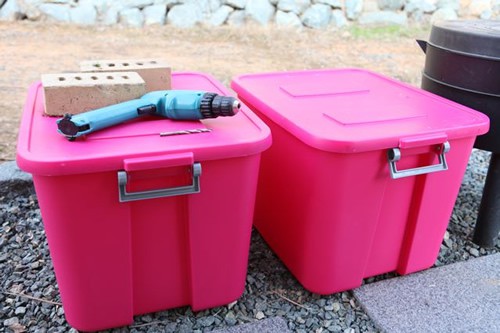
2 tubs (20 gallon), 2 bricks, drill, and ¼ inch bit.
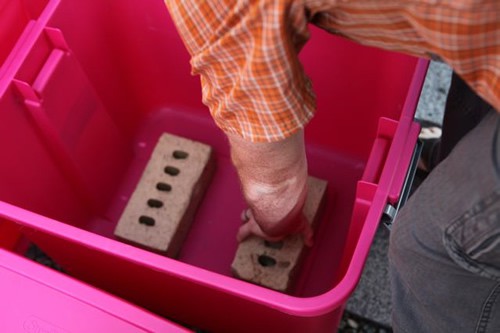
Place the bricks in the bottom tub (this is where excess liquid will drain, compost tea).
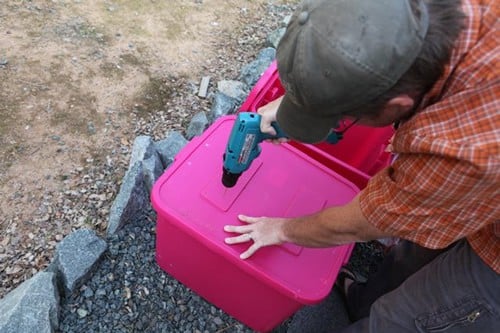
Drill about 25 holes in the top lid.
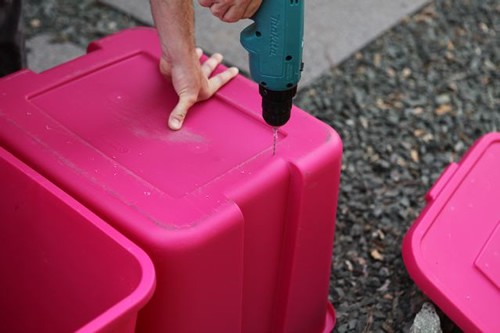
Drill about 20 holes on the bottom of the top tub.
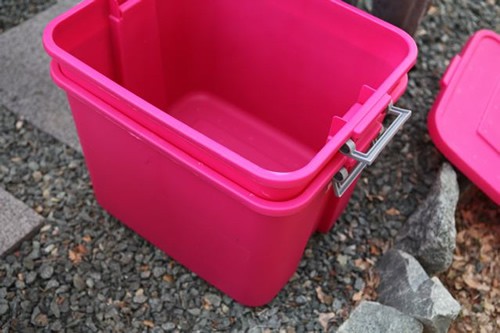
Place the tub with the holes in the bottom inside the tub with the bricks.
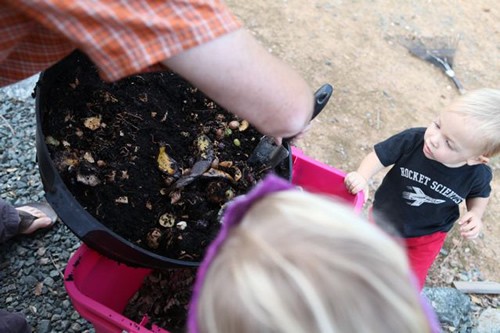
We divided the contents (worms, castings, food) of our Can-O-Worms tray into our new composter to set up the new army.
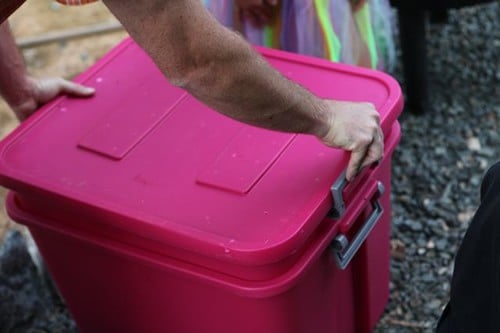
Snap the lid on (I really like the handles that snap – keeps the lid nice and secure) and our new composter was complete.
This was very simple to do. It has inspired me to divide both our composters again in three months and give new composter setups to friends and family who are not yet composting with worms. Who wouldn't want a worm composter for Christmas?
So I invite you to get some worms, build a composter, have some fun, and start making some of the best soil and compost you will ever work with.
Links and Resources
Commercial Worm Composters:
Books:
- The Worm Book: The Complete Guide to Gardening and Composting with Worms
- Worms Eat My Garbage: How to Set Up and Maintain a Worm Composting System
Live Red Worms:
This is a companion discussion topic for the original entry at https://peakprosperity.com/vermiculture-getting-down-and-dirty-with-worms-2/